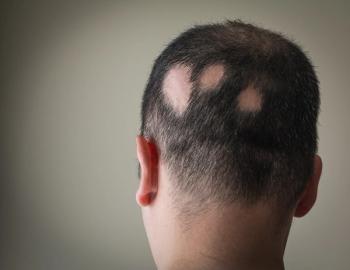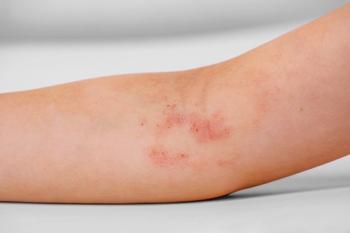
- Consultant for Pediatricians Vol 9 No 12
- Volume 9
- Issue 12
Green Teeth in a Child With Hyperbilirubinemia
A 26-month-old girl presented to the general nephrology clinic for evaluation of chronic renal insufficiency. During the examination, the physician noted green discoloration of the teeth.
Figure – The green discoloration of this child’s teeth is the result of severe hyperbilirubinemia.
The child’s bilirubin levels had been elevated above 20 mg/dL for 5 months.
A 26-month-old girl presented to the general nephrology clinic for evaluation of chronic renal insufficiency. During the examination, the physician noted green discoloration of the teeth (Figure).
The child was born at 38 weeks’ gestation via emergency cesarean delivery for placenta abruptio. Her weight, length, and head circumference were appropriate for gestational age. APGAR scores were 1, 1, 2, and 4 at 1, 5, 10, and 20 minutes, respectively. She was intubated and remained on a ventilator for 4 months. She had persistent hypotension and oliguria that required inotropic support with dopamine. At 2 weeks of age, she had meconium ileus with perforation and disseminated intravascular coagulation secondary to peritonitis. Enterococcus faecalis sepsis subsequently developed. She underwent terminal ileal resection of 15 cm with ileostomy. At that time, conjugated hyperbilirubinemia developed, with total and direct bilirubin levels of 34.7 mg/dL and 23.2 mg/dL, respectively. This was probably secondary to sepsis and total parenteral nutrition.
The bilirubin levels remained elevated for 5 months, despite treatment with phenobarbital. The mother reported that her daughter’s jaundice had resolved but that when her primary teeth erupted they had a greenish discoloration.
CAUSES OF DENTAL PIGMENTATION
Staining of the teeth in children has been well documented from various causes-the most recognized being tetracycline administration. Green dental pigmentation (chlorodontia) is relatively uncommon.
The causes of discolored teeth can be divided into 2 categories: intrinsic and extrinsic. Extrinsic staining occurs when deposition is outside of the enamel. Common causes of extrinsic staining include poor oral hygiene, iron preparations, dental caries, and fluorosis. Intrinsic staining is when the stain is incorporated into the enamel and dentin.1 Intrinsic staining is most commonly caused by tetracycline administration during gestation or during the years of tooth development. It may also present as a manifestation of dentinogenesis imperfecta or amelogenesis imperfecta, 2 genetic disorders of tooth development.2 Systemic illnesses (eg, congenital porphyria and congenital hypothyroidism) and metabolic diseases (eg, tyrosinemia and alpha1-antitrypsin deficiency) can also cause discoloration of teeth. Intrinsic green staining of teeth from hyperbilirubinemia is rare.3
GREEN TEETH AS A COMPLICATION OF HYPERBILIRUBINEMIA
Hyperbilirubinemia causes accumulation of bilirubin pigment within the skin and mucous membranes that manifests as yellow discoloration. In the newborn, jaundice becomes apparent on the face at a serum bilirubin level of about 5 mg/dL; it progresses caudally as the level increases.4 When bilirubin levels are elevated for several months, bilirubin pigments deposit throughout the body, including the teeth. Histological evaluation of green-stained deciduous teeth from patients with hyperbilirubinemia has shown bilirubin deposits.5 Intrinsic staining of primary teeth may vary in color from yellow to dark green. In the soft tissues, the pigment is removed over time. However, in the hard dental tissues, the pigment becomes trapped because of the lack of metabolic activity and thus results in permanent discoloration.3
Neonatal hyperbilirubinemia occurs in about 60% of newborns during the first week of life.4 However, the prevalence of green-stained teeth associated with hyperbilirubinemia is unknown. About 50 cases of green dental discoloration have been reported, mostly in the dental literature.3 Most of these cases occurred in children with hyperbilirubinemia secondary to biliary atresia. This raises the question of the role of direct hyperbilirubinemia in the pathogenesis of green-stained teeth. Perhaps because conjugated bilirubin is more water-soluble, it is able to be incorporated into the developing dentition.
Less common causes of green-stained teeth associated with hyperbilirubinemia include Rh incompatibility, ABO incompatibility, hemolytic disease, and sepsis. In a review of 48 children with green-stained teeth secondary to hyperbilirubinemia, the mean duration of jaundice was 24.6 weeks and the maximum serum total bilirubin level was 20 to 90 mg/dL.3 The primary teeth appear to be most affected, although staining of permanent dentition has been reported.6 Often, a sharp dividing line separates the normal-colored tooth from the green-stained portion.
The eruption of the first tooth is a much anticipated milestone in the developing child. The advent of a discolored tooth can be an unsettling surprise for parents. Thus, it is important to provide anticipatory guidance to families of children with severe hyperbilirubinemia.
MANAGEMENT OF STAINED TEETH
Treatment of pigmented teeth is mainly cosmetic. Stained primary dentition will eventually be replaced with normal permanent teeth. As children age, treating the teeth can help improve self-esteem, although most experts do not recommend treatment of primary teeth. Composite veneers or crowns and bleaching are 2 of the treatment options available for stained primary or permanent dentition.1
References:
REFERENCES:
1.
Rosenthal P, Ramos A, Mungo R. Managementof children with hyperbilirubinemia and greenteeth.
J Pediatr.
1986;108:103-105.
2.
Naudi AB, Ammari AB, Fung DE. A report of2 cases of green pigmentation in the primary dentitionassociated with cholestasis caused by sepsis.
J Dent Child (Chic).
2008;75:91-94.
3.
Guimarães LP, Silva TA. Green teeth associatedwith cholestasis caused by sepsis: a case report andreview of the literature.
Oral Surg Oral Med OralPathol Oral Radiol Endod.
2003;95:446-451.
4.
Plazza A, Stoll B. The fetus and the neonatal infant.Digestive system disorders. In: Kliegman R,Behrman R, Jenson H, Stanton B, eds.
NelsonTextbook of Pediatrics.
18th ed. Philadelphia; SaundersElsevier; 2007:756-761.
5.
Watanabe K, Shibata T, Kurosawa T, et al. Bilirubinpigmentation of human teeth caused by hyperbilirubinemia.
J Oral Pathol Med.
1999;28:128-130.
6.
Herbert FL, Delcambre TJ. Unusual case ofgreen teeth resulting from neonatal hyperbilirubinemia.
ASDC J Dent Child.
1987;54:54-56.
Articles in this issue
almost 15 years ago
Positional Plagiocephaly, Part 1:A Practical Guide to Evaluationalmost 15 years ago
A Collage of Genital Lesions, Part 5almost 15 years ago
Lessons From Colbyalmost 15 years ago
Transient Neonatal Pustular Melanosisalmost 15 years ago
Nail-Patella Syndromealmost 15 years ago
5-Year-Old Boy With Acute Illness and Chest Painalmost 15 years ago
Teen With Progressive Depigmented PatchesNewsletter
Access practical, evidence-based guidance to support better care for our youngest patients. Join our email list for the latest clinical updates.














